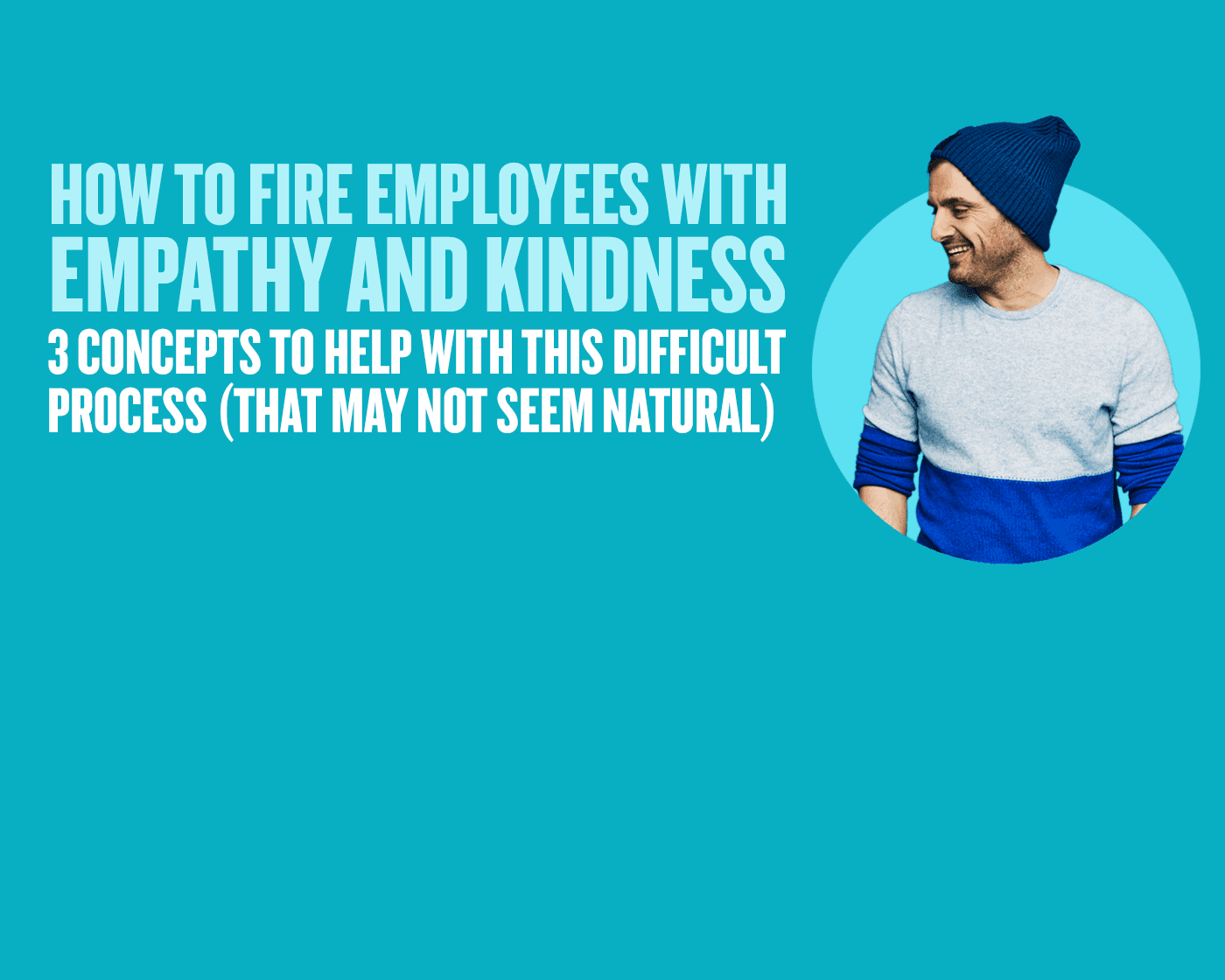There’s nothing worse in business than firing someone.
I’m not usually the one who does it at VaynerMedia anymore since we’ve grown to so many employees, but when I did I would spend a month figuring out how to make myself feel better about it.
We’re not in the one-, two- or three-strike policy here at VaynerMedia. We actually have enormous continuity, and I think part of that is thanks to the firing policy.
People see that we try to handle things with empathy and grace.

1. Try not to let the firing come as a surprise.
At VaynerMedia, we do our best to give employees as much feedback and help when they need it.
We work hard with people to try to help them achieve what they wanted to do when they came on board, or to help them find a better fit within the company. I think word of that effort gets around, and it makes people feel good about working here.
Here’s how to manage underperforming employees:
1. Take the blame.
2. Start to communicate better.
3. Ask them, “what can I do to help?”
4. And then actually start helping.
If you’re the founder or CEO of your company, everything that happens in your company is on you. If an employee is not performing, it’s super important to take a look at yourself and your processes first before blaming them.

2. Help them get another job somewhere else (where they might make more money).
Just because you had to fire someone doesn’t necessarily mean that they’re not good at their craft, or that they can’t succeed at a different company.
If someone gets let go at VaynerMedia, it could be for a variety of reasons. It could be that they’re not able to keep up with the pace of our execution. They might not be good managers, but they might be great at executing.
It could just be that we made a mistake and put them in the wrong position. They might have performed poorly because they didn’t click with their boss.
I’m super willing to help my employees transition out of my company into another role where they could be successful for one main reason:
I’m more interested in how I feel about myself and what those who know me say about me as a man than the profitability of my company.
It’s why I try really hard to keep strong relationships with my employees, even after they leave or get let go. It’s why I aim to deliver 51% of the value of that relationship.
People always talk about why employees shouldn’t burn bridges with employers, but not many people talk about the reverse of that. Not many people talk about employers keeping relationships with employees even when they let them go.
It’s also just practical.
I don’t want to name names or put people on blast, but there have been situations where an employee left or got let go from VaynerMedia, ended up going to work in-house at another brand and recommended working with VaynerMedia to that company.
Keeping those relationships has led to actual business. It’s something that most companies don’t think about.
3. Be willing to work with them on the narrative in the office (so they’re not embarrassed with friends).
A lot of companies struggle with this because they care more about the short-term money instead of building a long-term relationship with the person they’re firing.
I care about my employees. I care what they say about me. And when you care about something in perpetuity, you care how it ends in the short term.
That’s why I don’t think of my relationships with employees as transactional.
I think of it as the opposite.
I actually feel a sense of responsibility for people who worked for me, which is a big reason why I’m willing to give them value even after they leave.
When someone is let go, part of what they might struggle with is the narrative that’s being told in the office. Many would still have friends at work, so it’s important to be willing to work with them on the narrative you’re telling employees within the company.
At the end of the day, I don’t think people leaving my company or getting let go is the end of our relationship.
I think it’s the beginning of a new chapter.
If you got value from article, hit me up on Twitter and let me know what you thought!












https://maxpillsformen.com/# Cialis without a doctor prescription
Smash a tomato and add 2 tablespoons of lemon juice into it for the extra benefit of vitamin C. Mix it properly and then rub it from face to neck. Leave it for 15-20 minutes and wash the face with cold water. Place 4 teaspoons of papaya flesh in a bowl and mash it to a fine puree-like consistency. Add 2 teaspoons of honey to it. Adjust the proportions as needed; it should not be too runny or it will not stick to the face. Apply to the face and neck and leave for two hours. Remove with warm water. Honey hydrates the skin, while papaya enzymes stimulate natural skin whitening. 3. Besan pack Mix chickpea powder (besan), curd, and turmeric and rub it on your skin twice or thrice a week. Your mom too will support this as it is one of the best home remedies for skin. Instructions: Apply this paste over your skin and let it remain for 20 to 30 minutes then wash it off with normal water. This home remedy is one of the best effective home remedies for glowing skin.
https://super-wiki.win/index.php?title=Brow_bomb_brow_lamination
RRP: £20.00 Charlotte Tilbury Charlotte Tilbury New Body & Personal Care Tools & Devices An utterly adored make up brand that knows how to have fun, Too Faced began when its founders, Jerrod Blandino and Jeremy Johnson, became tired of the too-serious state of the cosmetics industry in the 90s. Championing unashamed femininity, a strong sense of fun and commitment to the transformative power of cosmetics, Too Faced has grown into an industry leader creating innovative, game-changing and cruelty-free cosmetics to crash your collection. “There’s no way you could ever shoot this thing accurately. Again, we have an issue of the eye-box and where your face has to be relative to the scope, and the recoil on a lightened Mosin like this that is still firing its full power 762×54 cartridge is significant. If you stick your eyeball up close enough to actually look through that scope, you’re going to get a black eye when you fire it. If I were actually going to get into a firefight with someone, I would be thrilled if that’s the gun they brought to a gunfight.”
Cialis 20mg price in USA Generic Tadalafil 20mg price Cialis over the counter
https://maxpillsformen.com/# Generic Cialis without a doctor prescription
online ed meds: cheap cialis – ed medications cost
https://fastpillsformen.com/# buy viagra here
Cheap generic Viagra FastPillsForMen.com Buy Viagra online cheap
cheapest erectile dysfunction pills: FastPillsEasy – what is the cheapest ed medication
https://maxpillsformen.com/# Generic Cialis without a doctor prescription
ed prescription online ed online treatment order ed pills online
buy erectile dysfunction pills online FastPillsEasy cheapest ed pills
sildenafil online: Fast Pills For Men – Buy generic 100mg Viagra online
cheapest cialis MaxPillsForMen Generic Cialis without a doctor prescription
п»їcialis generic: Max Pills For Men – Cialis 20mg price
best online ed medication FastPillsEasy how to get ed pills
yat?r?ms?z deneme bonusu veren siteler yat?r?ms?z deneme bonusu veren siteler deneme bonusu veren siteler
https://sweetbonanza25.com/# sweet bonanza demo oyna
https://slotsiteleri25.com/# en kazancl? slot oyunlar?
slot oyunlar? puf noktalar?: guvenilir slot siteleri – slot oyunlar?
https://casinositeleri25.com/# en yeni deneme bonusu veren siteler 2025
sweet bonanza yorumlar sweet bonanza giris sweet bonanza kazanma saatleri
https://sweetbonanza25.com/# sweet bonanza yorumlar
https://slotsiteleri25.com/# az parayla cok kazandiran slot oyunlar?
http://sweetbonanza25.com/# sweet bonanza kazanma saatleri
slot casino siteleri en kazancl? slot oyunlar? slot siteleri
canl? casino siteleri rcasino deneme bonusu veren casino siteleri
Deneme Bonusu Veren Siteler: deneme bonusu veren casino siteleri – casino bahis siteleri
sweet bonanza sweet bonanza guncel sweet bonanza giris
최저가격보장강남가라오케강남가라오케가격정보
최저가격보장강남가라오케강남가라오케가격정보
최저가격보장사라있네가라오케사라있네가격정보
최저가격보장선릉셔츠룸선릉셔츠룸가격정보
최저가격보장강남가라오케강남가라오케가격정보
최저가격보장강남셔츠룸강남셔츠룸가격정보
최저가격보장CNN셔츠룸씨엔엔셔츠룸가격정보
Rbviet.net Rbesports là nền tảng cá cược thể thao điện tử hàng đầu, mang đến trải nghiệm đặt cược trực tiếp cho hơn 10 tựa game đỉnh cao như LMHT, Dota 2, CS:GO, Valorant, PUBG… – 2025 March 28, 14:02
Cam kết minh bạch và an toàn, Rayesports.com Rayesports hợp tác cùng các giải đấu esports lớn, đảm bảo hệ thống cá cược công bằng và giao dịch chính xác, nhanh chóng. – 2025 April 04, 09:18
Профессиональный сервисный центр по ремонту бытовой техники с выездом на дом.
Мы предлагаем:ремонт крупногабаритной техники в москве
Наши мастера оперативно устранят неисправности вашего устройства в сервисе или с выездом на дом!
Tham gia ngay Rbviet.net Rbviet để tận hưởng cá cược esports chuyên nghiệp, với hệ thống bảo mật hàng đầu, giao dịch siêu tốc và hàng loạt ưu đãi dành riêng cho bạn. – 2025 April 10, 17:32
최저가격보장강남가라오케강남가라오케가격정보
최저가격보장강남가라오케강남가라오케가격정보
최저가격보장사라있네가라오케사라있네가격정보
최저가격보장선릉셔츠룸선릉셔츠룸가격정보
최저가격보장강남가라오케강남가라오케가격정보
최저가격보장강남셔츠룸강남셔츠룸가격정보
최저가격보장CNN셔츠룸씨엔엔셔츠룸가격정보
최저가격보장강남룸싸롱강남룸싸롱가격정보